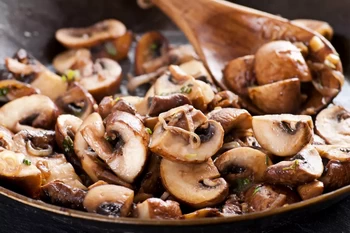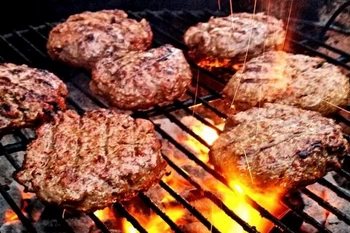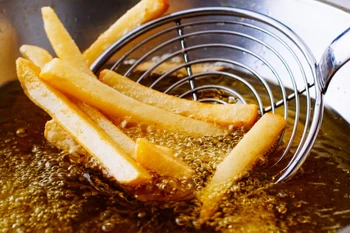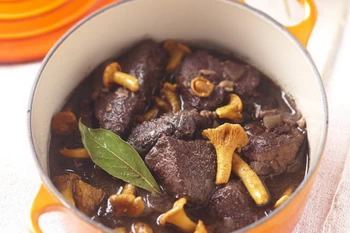This site uses only a few technical cookies necessary for its operation. By continuing to browse, you accept their use.
To find out more...
To find out more...
The different cooking modes
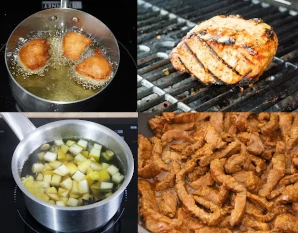
In cooking, cooking means bringing food into contact with a source of heat, to transform it: improving its taste, and sometimes its texture.
This contact with the heat source can be achieved in a number of ways: these are the cooking methods, and let's take a look at the main ones.
This contact with the heat source can be achieved in a number of ways: these are the cooking methods, and let's take a look at the main ones.
8,922 4.7/5 (24 reviews)
Keywords for this post:CookingFashionLexiconRoastPanBraiseSautéFryPoachLast modified on: July 24th 2024
The different cooking modes
Roasting |
| This means cooking, generally in an oven or on a spit, in a dry atmosphere (no steam). The aim is to obtain a nice brown color, a crust on the surface of the food, and a softness inside. Examples: Pork or veal roast |
Sautéing |
| Depending on its size, the food is cut into small pieces, then cooked quickly, uncovered and over high heat, with a small amount of fat, in a very hot saucepan, frying pan or sauté pan. Examples: Sautéed beef, vegetables or mushrooms. |
Pan-frying |
| Frying means cooking the whole food (or a small portion of it) in a pan over medium heat, covered or uncovered. Examples: Pan-fried fillet of sole or red mullet. |
Grilling |
| Quickly cooking food by placing it in direct contact with a heat source or a very hot surface: grill, barbecue coals, plancha. Examples: Barbecued steaks or burgers. |
Frying |
| Cooking food by plunging it directly into a fatty substance (oil, beef fat, etc.). Examples: French fries, fritters. |
Poaching |
| To cook a food by dipping it in an aromatic liquid (stock, juice, fumet, etc.). Examples: Poached pears, fish quenelles. |
Braise |
| The food, generally a whole piece (meat or other), is first seared on each side in a pan with a little very hot fat, then cooked slowly in a closed container that contains a base of liquid, often wine, but not completely immersed in it. Example: Braised beef with red wine and mushrooms. |
These are just the main cooking methods; professional chefs use others, which are often variations of these.
Source: "La cuisine professionnelle" by Yannick Masson and Jean-Luc Danjou.
Lasts posts
Butter vs. grease
We often read in a recipe where a pastry is put into a mould that, just before pouring, the mould should be buttered or greased. But what's the difference between these 2 terms?December 1st 20251,0015
Getting out of the fridge early
Very often when you're cooking, you need to take food or preparations out of the fridge, to use them in the recipe in progress. There's nothing tricky about this: you just take them out of the fridge and use them, usually immediately, in the recipe. But is this really a good method?November 24th 20251,1305
Who's making the croissants?
When you look at a bakery from the outside, you naturally think that in the bakery, the bakers make the bread, and in the laboratory, the pastry chefs make the cakes. It's very often like that, with each of these professions having quite different ways of working, but sometimes there's also one...November 23th 20251,022
Oven height
When we put a dish or cake in the oven, we naturally tend to put it on the middle shelf, and that's what we usually do. But in some cases, this position and height can be a little tricky, so let's find out why.October 8th 20252,7705
The importance of sieving
In recipes that use a fine powder (flour, powdered sugar, etc.), you'll often see the advice to sift before using it. To sift is to pass the powder in question through a sieve (a very fine strainer) before incorporating it into your recipe. It's often advice, but is it really useful?September 3rd 20257,5393
Other pages you may also like
Herbs and temperature
I have already talked to you about herbs in cooking, and about their great power of "seduction". The example of a salad is a great classic: on its own, it's a salad, which is normal, but the same salad in which you have added finely chopped fresh herbs, just before serving, you have much more than a...April 25th 202011 K4.8
Preserving egg yolks
If you're using only the egg whites in a recipe (such as meringues ), you'll need to store the yolks until you're ready to use them again. There's nothing very complicated about this in principle - all you have to do is chill them, but there are a few pitfalls to be avoided in practice.June 18th 20248,1365
Croutons
Do you use croutons, that typically French trick of toasting small pieces of bread on the side to add to a recipe? They're just delicious, but you need to know 2 or 3 things about them. .December 30th 202010 K5
Let's rehabilitate the burger
The burger is a sandwich that is very fashionable at the moment, and as for all other sandwiches, the worst (often) rubs shoulders with the best (much more rare). In principle, I'm probably not teaching you anything, it's a sandwich made of a small round bun, rather soft, like a sandwich bread,...April 10th 20219,7894.9
Beans in primeur
As I write this, it is the beginning of the short season for fresh beans. If you've never made them before and you're just starting out (and that's a great idea) you'll find that it's a bit time consuming to prepare, you have to shell them once, remove the beans, scald them to remove the skin (and...June 4th 202214 K
Post a comment or question
Follow this page
If you are interested in this page, you can "follow" it, by entering your email address here. You will then receive a notification immediately each time the page is modified or a new comment is added. Please note that you will need to confirm this following.
Note: We'll never share your e-mail address with anyone else.
Alternatively: you can subscribe to the mailing list of cooling-ez.com , you will receive a e-mail for each new recipe published on the site.

